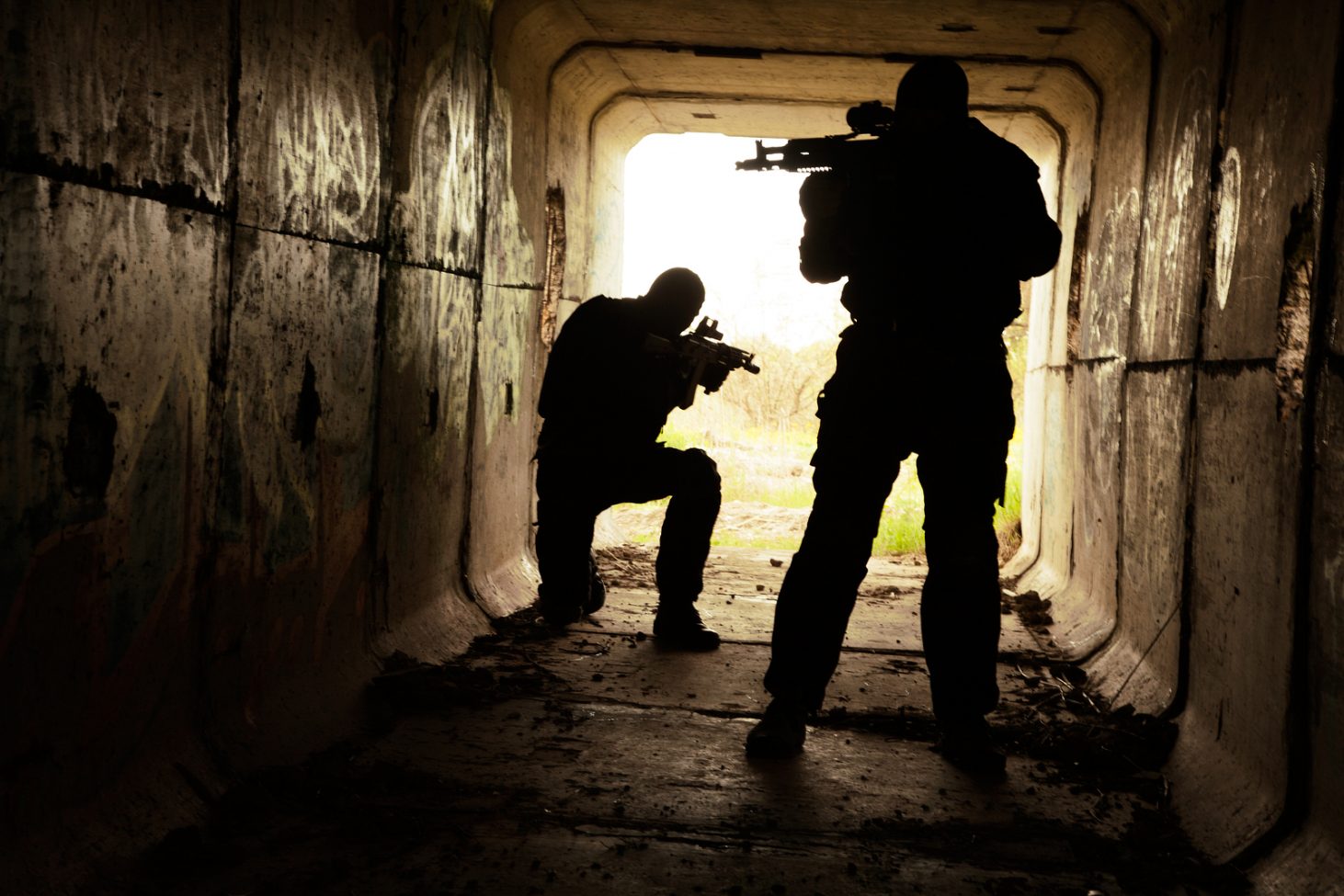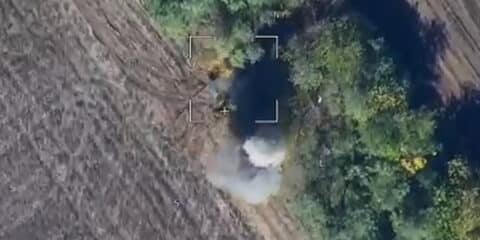Israel’s successful response to the underground threat has significantly limited the strategic abilities of its enemies, just as Israel has severely hampered the efficiency and purposefulness of rocket launches by terrorist organizations. This affords Israel room to maneuver if and when it decides to launch a wide-scale military operation in the Gaza Strip or Lebanon.
By using underground terrain, terrorist organizations can reduce the superiority enjoyed by regular armies that possess technological and firepower advantages. For the terrorist organizations, these tunnels are an important way of diversifying warfare and launching surprise attacks against states, at different levels: defense, attack, intelligence and logistics. The underground challenge has two categories: attack and defensive tunnels.
The tunnel threat may be classified at two different operational levels: routine security and a state of emergency. For routine security, dealing with the underground threat focuses on the tunnels used for smuggling goods and firearms, capturing soldiers, launching terror attacks and maneuvering. Dealing with the tunnels in a state of emergency becomes a bigger challenge because the fighting forces are forced to wage face-to-face, underground battle against the enemy. The regular army is required to deal with the underground challenge by designing and developing advanced intelligence, technological, engineering and operational (maneuvers) capabilities which will enable the fighting forces to locate, capture, hold and destroy the tunnels.
The Israeli public became aware of the underground threat following Operation Protective Edge when Hamas used the tunnels to defend itself from IDF soldiers in the Gaza Strip, to infiltrate Israeli territory, to kill or kidnap soldiers and to carry out a strategic attack against civilians. Just recently, with the launch of IDF’s Operation “Northern Shield” on the Lebanese border to expose and neutralize Hezbollah’s attack tunnels, the threat took on a new significance. However, the history of underground fighting is a long one, and even the State of Israel has had to deal with this threat several times. Back in the 1970s in the Gaza Strip, the IDF came across a primitive version of the threat which was inspired by the Vietcong. Israel also dealt with the underground threat in 2006, when IDF soldier Gilad Shalit was kidnapped, as well as during the Second Lebanon War, Operation “Cast Lead” and other military operations in the Gaza Strip.
The significance of this threat to the security of the State of Israel and its citizens and, in view of the improved operational capability of the terror organizations in digging and using the tunnels in recent years, necessitates research into this issue. The consequences of kidnapping an Israeli citizen or soldier are far-reaching and until the summer of 2006, when IDF soldier Gilad Shalit was kidnapped, Israel was not fully aware of the significance of this threat. As a result of Hamas and Hezbollah’s improved abilities in constructing tunnels in recent years and the increased use during Operation “Protective Edge”, Israel began viewing the underground threat as a new form of warfare, in addition to the existing ones in the air, on the ground, at sea, in space and cyberspace.
This paper analyzes the IDF’s buildup of forces, deployment and military operations against the underground threat. First, it assesses the underground threat posed by Hamas and other terrorist organizations in the Gaza Strip and by Hezbollah in Lebanon. Second, it examines the IDF’s past and present measures taken as part of the buildup of forces which include developing a combat doctrine and organizational, technological and intelligence efforts. The third part of this study reviews the IDF’s operations following the buildup of forces to face the underground threat.
Israel’s Underground Challenge
Terrorist organizations use two tactics to threaten Israel and its civilians: attack and defensive tunnels. The terrorists try to infiltrate Israel from Gaza through the tunnels on foot or by motorcycle and commit a strategic attack of kidnapping and murdering soldiers or civilians (and then make a speedy return through the tunnels). Up north, it appears that Hezbollah planned to send its elite force (“Radwan” Unit) through the attack tunnels to seize Israeli territory. In the Gaza Strip, the attack tunnels serve as hiding places during Israeli air force strikes or infantry operations against terrorists, as well as for transferring and hiding arms and other logistic equipment. The terrorist organizations, especially Hamas, have upgraded the use of tunnels to the point where the underground network has become a strategic and operational space which serves as a control center and includes the use of increasingly dangerous weapons. Israel has previously faced underground threats, first from the primitive tunnels in Gaza in the 1970s, and later in Lebanon. The IDF took the offensive against underground passageways in September 1996 and during the Second Lebanon war against “nature reserves” created by Hezbollah.[1] After the war, Hezbollah dug attack tunnels within Lebanese villages. During the ongoing Operation “Northern Shield”, the IDF exposed and neutralized five cross-border tunnels and still more are expected to be uncovered.[2]
During the “Ebb and Flow” events (the Second Intifada), the tunnels were used to smuggle arms from Egypt to the Gaza Strip and for attacks on IDF soldiers in the Gaza Envelope border region. Until June 2004, the IDF had destroyed over 100 tunnels. In addition, a trench digger was used to dig a ditch along the “Philadelphi” Route in Rafah, explosives were poured down shafts to destroy the tunnels, and houses close to the underground route were razed.[3]
In June 2006, following the Shalit kidnapping into a terror tunnel and the exposure of an additional tunnel reaching 1.3 km (0.8 miles) into Israeli territory which, according to Israeli intelligence was to be used to blow up the “Karni Crossing”, the IDF sped up its preparations for facing the underground threat. In February 2008, the IDF Planning Directorate unveiled its roadmap for fighting in the underground domain which was supposed to detail the plan for building up the IDF forces to improve preparedness for facing the threat. The Operations Division was charged with formulating operational strategy for dealing with the tunnels.
As part of the buildup of forces for dealing with the tunnel threat, the IDF was charged with organizing the OoB (Order of Battle); defining unit readiness; devising doctrines, tactics, techniques, and procedures; dedicated fire plans; setting up training bases; and equipping troops with suitable weapons and training.
At the end of 2013, the IDF and the “Shin Bet” (known formally as the Israel Security Agency, or the General Security Services) defined the tunnels in the Gaza Strip and Lebanon as a “strategic threat”.[4] Speaking at a security cabinet meeting on June 30, 2014, Prime Minister Netanyahu said that “the tunnels are a concrete threat to the State of Israel and they could alter the balance between us and them [Hamas]”[5] The State Comptroller’s report on Israel’s readiness for dealing with the tunnel threat noted that “the enemy’s widespread and efficient use of the attack tunnels as part of its defense strategy surprised the IDF and that the tunnels are an element that would continue to accompany future operations even more intensively.” Nevertheless, the Intelligence Directorate only in 2015 began treating the tunnel threat as a “top priority.”[6]
Development of Combat Doctrine for Underground Warfare
At the end of 2013, after a cross-border tunnel near Kibbutz “Ein HaShlosha” in the Gaza Envelope had been uncovered and neutralized in October, the pace of developing the combat doctrine was stepped up and a plan for dealing with the tunnel threat in times of calm was drawn up by the Southern Command, and later adopted by the General Staff for the entire IDF. However, the plan was not complete by the start of Operation “Protective Edge” and many holes remained in the plan, even after the operation was over. As a result, combat soldiers had to use ad-hoc measures for destroying tunnels or had to rely on earlier techniques that had been developed in 2006 for use against the smuggling tunnels at the “Philadelphi” Route. However, since these techniques were inappropriate, Israel was insufficiently prepared for the tunnel threat in Operation “Protective Edge”.
In July 2014, during the operation, the Chief Officer of the Combat Engineering Corps issued combat techniques for locating, mapping and destroying tunnels, especially cross-border attack ones. In December 2014, when the operation was over, the Chief Infantry and Paratroop Officer issued orders for Combat in a Tunnel-ridden Area which detailed the concept, principles, techniques and drills for combat in underground areas. These were based on the tunnel threat in the Gaza Strip and were intended for the Infantry and teamwork with the armored and engineering corps, the air force, intelligence and artillery forces. The Chief Infantry and Paratroop Officer issued combat orders for “Dealing with Threats during Routine Security” which contained a chapter on the tunnel threat.
Since Operation “Protective Edge”, the IDF has been designing a multi-dimensional and multi-force defensive plan against the attack tunnels from the Gaza Strip to prevent any enemy gains. General Staff operational plans for the south take the tunnel threat into account. The IDF trains existing units and has formed units specializing in underground warfare, and is building up technological and engineering forces to deal with the tunnels and to plan goals for a state of emergency. As part of this plan, the IDF is writing and updating the concepts, combat doctrine and techniques for the Southern Command, Ground Forces and General Staff. New concepts were written and approved for the General Staff and Ground Forces. A joint team has began writing an operational concept for the tunnel threat and professional codes for defense and maneuvers were written for the forces, stressing combat ability in tunnel-ridden areas. In addition, joint teams have began working on defining the threat and reference scenario.
The Organizational Effort
The IDF took advantage of the Engineering Corps’ existing technical and technological capabilities, before even working on organizational efforts for dealing with the tunnel threat. Back in 2013, the “Samoor” (Weasel) company for arms caches and tunnels, which is part of “Yahalom” (the special engineering battalion) had been charged with this task. Using technological means, “Samoor’s” expertise is in underground combat and in identifying and destroying tunnels. As part of the effort, the “Knights of Steel” Special Engineering Vehicle unit worked in partnership with the Gaza Division and provided heaving duty equipment to assist in digging and uncovering efforts.[7]
As part of the lessons learnt from Operation “Protective Edge”, the “Yahalom” battalion was reorganized and two new sub-units were formed: S1 – a merger of “Yael”, the commando demolition unit, and “Samoor” company; and S2 – comprising the SAP Explosive Ordnance Disposal company. S1 is considered to be the elite Engineering Corps unit and in the last two years three new underground companies were formed, one in active duty and two in reserve. S1 operates under the command of the Gaza Division and is charged with locating, mapping and demolishing attack tunnels. The unit is tasked with integrating ground data with intelligence and technological data to form a consolidated operational product.[8] As part of the Engineering Corps reorganization, “Yahalom’s” size was doubled from 400 to 900 fighters, whose expertise is complex engineering tasks. Thus, in the next engagement the forces trained to deal with tunnels will be twice as large as it had been in Operation “Protective Edge”.[9]
“Yahalom” combat fighters operate in the southern region as part of anti-tunnel operations, but also have a heavy load of other emergency roles. Therefore, Yehuda Fuchs, the previous Gaza Division commander decided to set up a designated underground fighting unit, thus creating a specialized and skill force for underground warfare. The unit’s initial core comprised fighters from various units, including observation and reconnaissance fighters, to form an expert commando force skilled in operating sensors, identifying tunnels whose ongoing task will be “regular tunnel security” and who will be provided with state-of-the-art technological equipment. The force is directly answerable to the Gaza Division commander.[10]
Since May 2018, two companies consisting of decipherers and soldiers specializing in locating and uncovering underground attack tunnels, operate as part of the intelligence battalion of the Gaza Division, without needing the support of General Staff special forces or other designated units. A company consisting of two platoons was attached to each territorial brigade in the Gaza Division. One of the platoons is for underground deciphering and the other, consisting of male and female reconnaissance fighters use special means.[11]
Before enlisting, the female decipherers undergo interviews and security clearing. Their training consists of a deciphering course at the Combat Intelligence school, followed by professional training at “Elbit” and then they are appointed to operational tasks in the area. Thus, during their training, the female soldiers acquire a comprehensive knowledge of underground deciphering. The fighters are trained by “Yahalom”, and upon completion of the course, join the battalion. While the decipherers are on duty in the underground command room using sensors to detect any suspicious activity, the reconnaissance fighters conduct patrols and ambushes using special means.[12]
In June 2018, Brig. Gen. Fuchs decided to set up a division underground combat structure, starting with a new laboratory known as “The Brain”. Members of this team include Defense Ministry personnel, geologists, intelligence officers, combat doctrine designers, content experts and military and civilian advisors. The second stage is to set up designated command rooms in the northern and southern brigades. They will be charged with coordinating all the gathered intelligence and transferring it to the field. The forces will conduct various tests to rule out the possibility of any new digging and to assist in mapping out, neutralizing and demolishing tunnels. Furthermore, analyzing the data sent from the sensors along the Gaza border demands a high level of competence and professionalism so a special training school has been set up for the female soldiers managing the command rooms. They will be taught how to store and analyze the data and use it to help identify tunnels.[13]
The Israel Air Force (IAF)has also undergone organizational change. During Operation “Protective Edge”, the Air Intelligence group gathered information from the list of targets prepared before and during the operation. The IAF also participated in bombing the tunnels in the Gaza Strip. However, due to a lack of intelligence, appropriate operational plans (regulations for opening fire on Israeli territory) and a lack of coordination with other forces, the IAF’s attacks on the tunnels were not efficient and successful.[14] Once the operation was over, the IAF made several changes to improve its integration into underground warfare. The areas of responsibility of those leading the air strikes and the professionals dealing with the underground threat were delineated. The command and control structure were defined, as well as the operational concept practiced in drills. In coordination with the Southern Command engineering officer, several exercises were conducted. The IAF carries out additional operations to cope with the threat.[15]
The Technological Effort
The IDF and MoD have invested considerable resources, especially technological, in dealing with the tunnel threat. The emphasis has been on R&D in the search for technologies that provide solutions for this complex threat.[16] The three areas of research have been building a defensive infrastructure; designing and purchasing equipment for locating, uncovering, mapping and demolishing tunnels, and developing weapons to combat the tunnel threat.
Defensive Infrastructures
In June 2016, the MoD decided to construct a barrier along the 64 km (40 mile) Gaza border to meet the tunnel threat. Construction began in 2017, and the expected cost is NIS 3 billion, a reflection on how Israel perceives the underground threat. The barrier has several technological features, including a “smart” fence, underground concrete walls, sensors to identify tunnels and advanced offensive and defensive means.[17] In 2018, sensors were installed along the entire border to identify any cross-border tunnels.[18]
Design and Purchase of Equipment for Locating, Uncovering, Mapping and Demolishing Tunnels
Until 2010, significant resources and efforts were invested in locating and uncovering tunnels, especially the “Movil Ehad” project. However, the project failed and was disbanded in December 2009 during operational testing. In 2010, an “emergency project” was initiated, led by the Ground Forces in conjunction with the Administration for the Development of Weapons and Technological Infrastructure (MAFAT), the Southern Command and the Gaza Division. In January 2013, the head of the planning division gave final approval to the project, which had been successfully tried before Operation “Protective Edge”. Although the projected completion date was the end of June 2014, it was not fully operational when “Protective Edge” broke out in July 2014, and was only completed a year later at the end of March 2015.[19] The system was partly installed in the beginning of 2016 and around that time, the decision was made to extend the system along the entire length of the Gaza border.[20]
Weapon Development to Combat the Tunnel Threat
Due to inadequate technologies for dealing with the underground threat, the various army units devised independent initiatives which attempted to develop, purchase or locate products that would minimize the shortfalls in dealing with the threat and circumvent the formal R&D procedures. For example, the “Givati” Brigade independently developed tunnel locating mechanisms.[21]
An infantry unit belonging to MAFAT’s Division of Armed Systems and Armored Vehicles was set up only in 2013 and began closing the technological gaps in underground warfare.[22] Since Operation “Protective Edge”, significant progress has been made in the Ground Forces in dealing with the tunnels during ground maneuvers. In November 2014, the masterplan for improving how the ground forces deal with the tunnel threat during states of emergency was implemented, and most of the plan’s initiatives have already been completed.[23]
The Intelligence Effort
The importance of intelligence has grown significantly in modern warfare which is no longer characterized by battles between states and regular armies, but by asymmetry, urban warfare, proximity to civilian populations and, in many cases, by ambiguity. In underground warfare, the goal of intelligence is to locate and identify the existing and planned gaps and spaces and to pass the information to the ground forces as part of intelligence-based warfare.
Since 2008, Israel has invested in intelligence gathering about the underground threat, relying on the Intelligence Directorate and the ISA. These efforts include attempts to locate tunnels and those involved with the project.[24] In February 2008, the Planning Directorate published the roadmap for fighting the underground threat and noted the existence of several cross-border tunnels defined as “ticking time bombs” that could result in a strategic attack whenever the enemy chooses to act. Despite the IDF’s statement that the “most important challenge of underground warfare is the intelligence one”, intelligence gaps about the attack and defense tunnels in the Gaza Strip existed, as evidenced by the difficulty to pinpoint the tunnels openings and layouts.[25]
As a result of the intelligence that had already been gathered up to that point, from the end of 2013 the Military Intelligence Directorate (“Aman”) and the ISA stepped up their efforts to gather intelligence about the attack tunnels originating in Gaza. Furthermore, because of this need, an Aman demand for reliable intelligence on tunnels was incorporated in 2013 and 2014 and thus much valuable information was gathered about these tunnels.[26] Israel’s operational capacity during Operation “Protective Edge” was significantly improved thanks to intelligence gathering effort.[27] Although many details are still classified, Operation “Northern Shield” is also based on detailed intelligence.
Military Operations Against the Tunnel Threat
IDF military operations against the Gaza tunnels include use of air, ground and underground space as well as intelligence and advanced technological means. A widespread sophisticated observation system operates around the Gaza Strip and involves IAF UAVs and reconnaissance flights, and special means for identifying tunnels. The IDF also excavates in suspicious areas, sends cameras and robots to infiltrate the tunnels (in certain cases, fighters are also sent into the tunnels), uses special radar equipment for underground mapping and heavy machinery for digging identifying ditches.
During Operation “Protective Edge”, various methods were used to demolish the tunnels, such as aerial bombing, flooding to bring about their collapse, and gel-like explosives. Prior to the start of the operation, IDF commando units were trained in tunnel warfare. During the operation, the IDF destroyed 32 terror tunnels, one third of which were cross-border tunnels[28] and operations continued after the “Protective Edge”. Until December 2018, the IDF has destroyed 17 tunnels leading from the Gaza Strip into communities in southern Israel.[29]
Israel has also had to contend with a tunnel threat on its northern border and embarked on Operation “Northern Shield” on December 4th, 2018 with the stated goal of uncovering and neutralizing Hezbollah cross-border tunnels from Lebanon. During the ongoing operation, five such tunnels have been uncovered. The tunnels were planned to be used by Hezbollah’s commando unit Radwan to infiltrate Israel, capture a community, cut off Israeli forces from main routes and kidnap soldiers and civilians.
Due to the different topography in the north, the IDF had to use alternative methods for uncovering and neutralizing the tunnels. Whereas the soil in the south is alluvial and the IDF digs in sandy clay soil, the terrain in the north is limestone rock. Senior officers from the Northern Command visited their counterparts in the south to learn about the Hamas terror tunnels, but understood that the diggers used in the sandy soil are of no use in the north.[30] Moreover, each tunnel in the north has its own unique features: some are hewn out of rock, others are made from cement, and ascend or descend into Israeli territory, and so different methods are used to neutralize them.[31]
Up to the present operation, the IAF used UAVs for surveillance of trucks suspected of hauling away debris from tunnels and the “Galil” Division used other means to gather intelligence. During the last year, the IDF embedded seismic sensors enabling them to listen to the excavations. It was easier to identify noise from tunnel digging in the rocky soil in the north than in the sandy soil in the south. A special task force was charged with conducting additional technological tests at test sites in the Galilee region which helped uncover the tunnels’ layouts.[32]
Summary
The political and security heads of the country have defined the underground tunnels as a “strategic” threat to the State of Israel, although some security officials oppose this definition. During a Parliament debate in March 2017, IDF’s Chief of Staff General Gadi Eizenkot said that “the underground threat is most serious, and we treat it as such, but I would not go as far as to say that it is an existential or strategic threat.”[33]
Thanks to quality, though insufficient, intelligence, Israel was sensitized to the tunnel threat during the campaign against Palestinian terror in the Gaza Strip and later in the Second Lebanon war and the rounds of fighting against Hamas in Gaza. The Israeli public became aware of the threat in the summer of 2014 during Operation “Protective Edge” when 32 cross-border terror tunnels were uncovered and destroyed. Despite intelligence on the tunnels, Israel was not properly prepared to deal with the threat. The lack of ability and unwillingness to deal with the threat was reflected in June 2006 when Hamas kidnapped Gilad Shilat using a cross-border tunnel in 2014 when Israel faced technological difficulties in uncovering and neutralizing the tunnels during Operation “Protective Edge”.
The defense establishment is now more prepared than ever to deal with underground threats. Since Operation “Protective Edge”, the IDF has revamped and significantly improved its intelligence and technological capabilities and the fighting forces have trained to improve their operational performance against the tunnel threat. The change in knowledge and capabilities is evident in the location, uncovering and demolition of many cross-border attack tunnels since the end of Operation “Protective Edge”.
Israel is waging a campaign to limit the terror organizations from using the tunnels as part of a wider strategy to prevent them from gaining any achievements. This strategy includes the “Iron Dome” and “Magic Wand” air defense systems to intercept the medium range high-trajectory weapons (the “Arrow” system is used against long-range missiles). Israel is also working on finding a solution to short range high-trajectory weapons where there is very little warning time. Furthermore, Israeli is taking the offensive in both geographically near and far regions to prevent the terrorist organizations from acquiring advanced weapons such as precise, long-range missiles.
Israel’s successful response to the underground threat has significantly limited the strategic abilities of its enemies, just as Israel has severely hampered the efficiency and purposefulness of rocket launches by terrorist organizations. This affords Israel room to maneuver if and when it decides to launch a wide-scale military operation in the Gaza Strip or Lebanon.
Nevertheless, the underground barrier along the Gaza border has not yet been completed, and it seems that this has tempered the IDF’s reaction to Hamas provocations over the past year (– which were initiated, among other reasons, by Hamas and other terror organizations in order to delay the completion of the barrier). Israel prefers not to be dragged into a military conflict before its defensive capabilities are fully operational. In this context it is worth noting that Israel is also proceeding cautiously in the north and is avoiding a full-blown confrontation with Hezbollah. Israel’s reasons for this policy need a separate discussion.
1 Shapir, Y Perel G. Subterranean Warfare: A New-Old Challenge. The lessons of Protective Edge, Kurz A., Brom S. (eds) The Institute for National Security Studies. Tel Aviv, 2014.
www.inss.org.il/…/subterranean-warfare-a-new-old-challenge
[2] Dostri, O. Operation Northern Shield – Part of a broad Israeli campaign in Lebanon. The Jerusalem Institute for Strategy and Security. December 6, 2018 (Hebrew)
http://jiss.org.il/he/dostri-operation-northern-shield-part-of-a-broad-israeli-camaign-in-lebanon/
[3] Note 1, p. 50
[4] Sadan, I. “The Comptroller. ‘ IDF surprised by tunnels – acted ad-hoc without combat plan’.” Walla News. February 28, 2017 (Hebrew), https://news.walla.co.il/item/3044193
[5] Yehoshua, Y. “Scoop – Tense cabinet decisions during Protective Edge published”. Ynet. January 24, 2017 (Hebrew)
https://www.ynet.co.il/articles/0,7340,L-4911896,00.html
[6] Note 4.
[7] Levy, S. “How does the IDF uncover tunnels? Declassified information. Mako. October 14, 2013 (Hebrew)
https://www.mako.co.il/pzm-units/combat-engineering/Article-06ce1e77206b141006.htm
[8] Rot, Y. “Retiring founder of elite tunnel warfare unit talks” Walla News. June 26, 2018 (Hebrew), https://www.maariv.co.il/news/military/Article-653351
[9] Buhbut, A. “Tunnel hunters – the Gaza Division sets up underground warfare unit” Walla News. June 26, 2018 (Hebrew), https://news.walla.co.il/item/3168562
[10] Ibid.
[11] Teshuva, A. “New underground intelligence unite in Gaza Division” IDF website. July 19, 2018. (Hebrew)
[12] Ibid.
[13] See note 9
[14] “Handling the tunnel threat” State Comptroller’s report, February 28, 2017. p. 28 (Hebrew)
http://www.mevaker.gov.il/he/…/zuk-eitan-20.pdf
[15] Ibid. p. 28-29
[16] Ibid. p. 37
[17] Tsuri, M. “The ‘barrier’ on the Gaza border will cost NIS3.34 billion”, Ynet. January 9, 2017 (Hebrew), https://www.ynet.co.il/articles/0,7340,L-4904917,00.html
[18] Buhbut, A. “We are not relying on regulation: experimental bases set up along Gaza border for underground warfare” Walla News. August 23, 2018 (Hebrew)
https://news.walla.co.il/item/3182870
[19] See note 14, p. 38-39
[20] Ibid. p. 43.
[21] Ibid. p. 41.
[22] Ibid. p. 39.
[23] Ibid. p. 41.
[24] Ibid. p. 16.
[25] Ibid.
[26] Ibid p. 17
[27] Ibid, p. 19
[28] Cohen, G. Harel, A. “Without plans, training and equipment – IDF faced the tunnels”, Haaretz. October 17, 2014 (Hebrew)
https://www.haaretz.co.il/news/politics/.premium-1.2460677
[29] Zeitoun, Y. “Explosion or Storm: the scenarios that could lead to counter-response from Hezbollah” Ynet. December 5, 2018 (Hebrew)
https://www.ynet.co.il/articles/0,7340,L-5420206,00.html
[30] Zeitoun, Y. “The surprise, studying in Gaza and the planning: Behind the scenes of Northern Shield” Ynet. December 5, 2018 (Hebrew)
https://www.ynet.co.il/articles/0,7340,L-5420466,00.html
[31] “Northern Shield: Neutralization and demolition of terror attack tunnels begins.” IDF website, December 20, 2018 (Hebrew)
[32] Ibid.
[33] Nahshoni, K. “Eizenkot on tunnel threat: ‘Serious but not existential or strategic'” Ynet. March 22, 2017 (Hebrew)
https://www.ynet.co.il/articles/0,7340,L-4938919,00.html
photo: Bigstock









 - בניית אתרים
- בניית אתרים